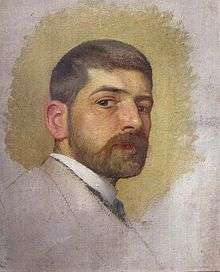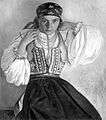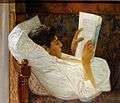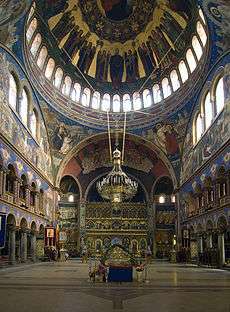Octavian Smigelschi
| Octavian Smigelschi | |
|---|---|
 self-portrait | |
| Born |
March 21, 1866 Nagyludas, Szeben County, Austria-Hungary |
| Died |
November 10, 1912 (aged 46) Budapest, Austria-Hungary |
| Resting place | Blaj, Romania |
| Nationality | Romanian |
| Known for | Painting |
| Notable work | Interior painting at Holy Trinity Cathedral, Sibiu |
Octavian Smigelschi (Hungarian: Smigelschi Oktáv; March 21, 1866 – November 10, 1912) was an Austro-Hungarian Romanian painter.
Biography
Background and early life
His father Mihail (Śmigielski) came from Poland. According to historian Nicolae Iorga, the family descended from chorąży (standard-bearers) to the Polish king. Another writer suggests a Ruthenian background; Mihail was Greek-Catholic, and the Austrian Partition of Poland was home to numerous Ruthenian Greek-Catholics. (However, he does allow for the possibility that the elder Smigelschi adopted the faith after arriving in Transylvania.)[1] Octavian Smigelschi's own ethnic identity has been subject to some debate, with both Polish and Hungarian suggested, but he considered himself as Romanian.[2] His father was a member of the szlachta noble class who fled Poland following the 1848 Revolution and arrived in the Principality of Transylvania in 1850.[3][4] Initially settling in Bungard,[1] he married Ana Sebastian, an Aromanian from Macedonia and also a Greek-Catholic.[1][4] Later, he moved to Nagyludas in Szeben County, now Ludoș, Sibiu County, to work as a notary. There, he had four sons. One of them, Victor, obtained a Theology doctorate from the University of Vienna, teaching the subject and serving as a canon in Blaj. Another, Vasile, became an architect and was influenced by Romanian national ideas.[1]
Octavian began school in his native village, and in 1880 enrolled at the state Hungarian high school in Sibiu. There, he became close friends with Fritz Schullerus, and the two took art classes from Carl Dörschlag, a German immigrant. Following graduation in 1884, he obtained a public scholarship to study at the art teachers' school in Budapest, headed by Bertalan Székely, together with Schullerus.[5] He completed his work there in 1889.[3] The following year, he was named art teacher in the Slovak town of Banská Štiavnica.[5] That year, he held his first exhibition in Sibiu, alongside Schullerus and another Transylvanian Saxon colleague. In 1892, he was hired to teach art at the state high school in Dumbrăveni. He held this position until 1911, when he retired in order to focus on painting, although from 1905, when he moved to Sibiu, he was on a leave of absence for the same reason.[6] As the 1890s went on, he became increasingly drawn to Art Nouveau.[7] Beginning in 1898, he undertook trips to Munich, Dresden, Vienna, Budapest, Florence, Rome and Ravenna, studying the local Renaissance art.[3][6] In 1903, he held his second exhibition in Blaj, featuring exclusively religious works, including a plan for painting the Greek-Catholic cathedral. That October, his third exhibition took place in Sibiu, with 71 secular paintings and drawings.[8] Among the displays was a 7 x 5 m carpet woven by peasant women from Maramureș based on his indications. The show drew universal acclaim due to the newness of his style and the combination of popular Romanian motifs and peasant folk art he employed. The fourth exhibition occurred the same year in Budapest, and was praised as well, including by Octavian Goga in Luceafărul.[9]
Sibiu cathedral and later years
Meanwhile, the old Romanian Orthodox cathedral in Sibiu had been demolished in 1902 and a new building begun.[8] A competition for the painting opened in November 1903, with fifteen Romanian, German and Hungarian participants.[10] A committee composed of George Demetrescu Mirea, Ion Mincu and Friedrich Miess narrowed the field down to three finalists. In April 1904, Smigelschi was selected to execute the interior painting.[11] He was paid 32,000 crowns for the cupola, the pendentives and the iconostasis.[12] At this time, he began to focus on traditional styles of painting, seeking to strike a balance between large-scale murals and the architectural surroundings which they were not supposed to overshadow. Accordingly, in 1904, he crossed into the Romanian Old Kingdom as well as Bukovina in order to study the churches and monasteries where the country's spiritual heritage is expressed,[11] familiarizing himself with the Byzantine style that came to complement his knowledge of Renaissance painting.[3] He analyzed old painted churches at Tismana, Cozia, Bistrița, Horezu, Curtea de Argeș, Bucharest, Snagov, Sinaia, Iași, Suceava, Sucevița, Dragomirna, Putna, Rădăuți, Humor, Voroneț and Cernăuți.[13] His own work, in churches at Șanț, Rădești, Sibiu, Ciacova and elsewhere, reflects attention to tradition but not a mere reproduction thereof. From Byzantine art he took the monumental size and decorative look; this was infused with the Renaissance and German schools, in particular Arnold Böcklin, to create a neo-Byzantine style most evident in the Sibiu cathedral.[12] In a number of Transylvanian churches, particularly in the Năsăud area, he painted icons and sometimes entire iconostases.[3]
After moving to Sibiu in 1905,[12] he was able to complete his commission there by the time the new cathedral was dedicated in May 1906.[14] As a speaker of German and Hungarian, he fit easily into the city's artistic milieu.[7] Features of his cathedral work include Christ Pantocrator in the cupola, the Four Evangelists on the pendentives and the painted iconostasis. Romanian folk motifs are used in the clothing worn by the Three Magi, the shepherds and the child angels with the star, while the Nativity of Jesus is transposed to a Romanian setting.[15][16] Mircea Păcurariu suggests that the Magi are each inspired by a ruler of the Romanian provinces (Moldavia, Wallachia and Transylvania): Alexander the Good is taken from Sucevița, Neagoe Basarab from Curtea de Argeș and Matthias Corvinus from a period engraving.[17] In 1907, along with painting at Ciacova, he donated funds to the families of those killed during the peasants' revolt. The following year, he won a competition for the Vilmos Fraknói prize, guaranteeing him 3000 crowns annually, a studio and a residence in Fraknói's Rome house. He also organized an exhibit in Budapest, drawing favorable mentions in the local press.[18] In 1909, he painted the Greek-Catholic church in Rădești. During this time, he began to show symptoms of heart disease that grew progressively worse. He received an order for painting the altar in a Rákóczi chapel in Hungary, which remained unfilled, while painting for the Blaj cathedral and the remainder of the Sibiu cathedral was left in the planning stages. He intended to execute a triptych for the 1911 International Exhibition of Art in Rome, but this remained undone due to a heart attack. In 1912, with his disease worsening, he left for treatment at Bad Nauheim. He then traveled to Budapest, where he took part in a contest for painting a chapel in Košice. Smigelschi died in Budapest in November 1912. His brother Victor claimed the remains and he was buried in Blaj.[19]
 Lina cu mărgele ("Quiet Girl with Beads")
Lina cu mărgele ("Quiet Girl with Beads") Portretul unei tinere ("Portrait of a Young Woman")
Portretul unei tinere ("Portrait of a Young Woman") Tânăr citind ("Young Man Reading")
Tânăr citind ("Young Man Reading") Sibiu cathedral interior
Sibiu cathedral interior- Detail of angels
- Cupola with Christ Pantocrator in the center
Notes
- 1 2 3 4 Gogâlea, p.15
- ↑ Gogâlea, p.10
- 1 2 3 4 5 Păcurariu, p.27
- 1 2 Oprescu, p.816
- 1 2 Gogâlea, p.16
- 1 2 Gogâlea, p.17
- 1 2 Gogâlea, p.11
- 1 2 Gogâlea, p.18
- ↑ Gogâlea, p.19
- ↑ Gogâlea, p.19-20
- 1 2 Gogâlea, p.20
- 1 2 3 Gogâlea, p.21
- ↑ Gogâlea, p.20-21
- ↑ Gogâlea, p.21-22
- ↑ Gogâlea, p.13
- ↑ Păcurariu, p.28, 30
- ↑ Păcurariu, p.30
- ↑ Gogâlea, p.22
- ↑ Gogâlea, p.23
References
- (Romanian) Dorin Gogâlea, "Octavian Smigelschi", Seria Personalia, nr.1, Biblioteca Judeţeană ASTRA, Sibiu, 2006
- (Romanian) George Oprescu, "Octavian Smigelschi desenator", Transilvania, nr.10-12/1944, p. 816-20
- (Romanian) Mircea Păcurariu, "Pictura lui Octavian Smigelschi din catedrala mitropolitană din Sibiu", Transilvania, nr.4/2006, p. 27-30
External links
| Wikimedia Commons has media related to Octavian Smigelschi. |